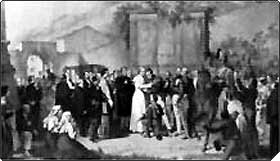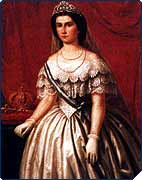 Once the King and Queen departed they were deprived, without justification, of their personal assets by the newly founded Savoy-led Kingdom of Italy causing them to live a modest and peaceful life. In exile first in Rome, the King and Queen were the guests of Pope Piux IX (left) who did so no doubt recalling the hospitality he had received in Gaeta from 1848-1850, and his predecessor Pope Pius VI in 1798. The King and Queen were first housed directly by the Holy Father before moving to live in the family-owned Palazzo Farnese in central Rome.
Once the King and Queen departed they were deprived, without justification, of their personal assets by the newly founded Savoy-led Kingdom of Italy causing them to live a modest and peaceful life. In exile first in Rome, the King and Queen were the guests of Pope Piux IX (left) who did so no doubt recalling the hospitality he had received in Gaeta from 1848-1850, and his predecessor Pope Pius VI in 1798. The King and Queen were first housed directly by the Holy Father before moving to live in the family-owned Palazzo Farnese in central Rome.

During the years that followed pro-Bourbon uprisings occured among the southern populations and especially so against the Piedmontese government. King Francesco II maintained contact with his people and materially helped the most important leaders of the legitimist counter-revolution.
The counterrevolution was defeated in bloodshed, and as the years went by it became clearer that the “miracle” of 1799 would not be repeated, despite the same utmost loyalty shown by many of his former subjects. In 1870 Rome was invaded, and Pope Pius IX was forced to limit his dominions to the Vatican itself. In turn this forced King Francesco II and his consort to leave for a new exile which including Trento, Paris and Bavaria. King Francesco II never gave up his lawful rights and claim to the Throne of the Two Sicilies.
 During one of these overseas visits to Trento, in 1894, King Francesco II died. The King did not have any heir, and therefore his younger brother, Prince Alfonso Maria of Bourbon Two Sicilies, Count of Caserta, succeeded him as Head of the Royal Family. Queen Maria Sofia later died in Munich in 1925.
During one of these overseas visits to Trento, in 1894, King Francesco II died. The King did not have any heir, and therefore his younger brother, Prince Alfonso Maria of Bourbon Two Sicilies, Count of Caserta, succeeded him as Head of the Royal Family. Queen Maria Sofia later died in Munich in 1925.
